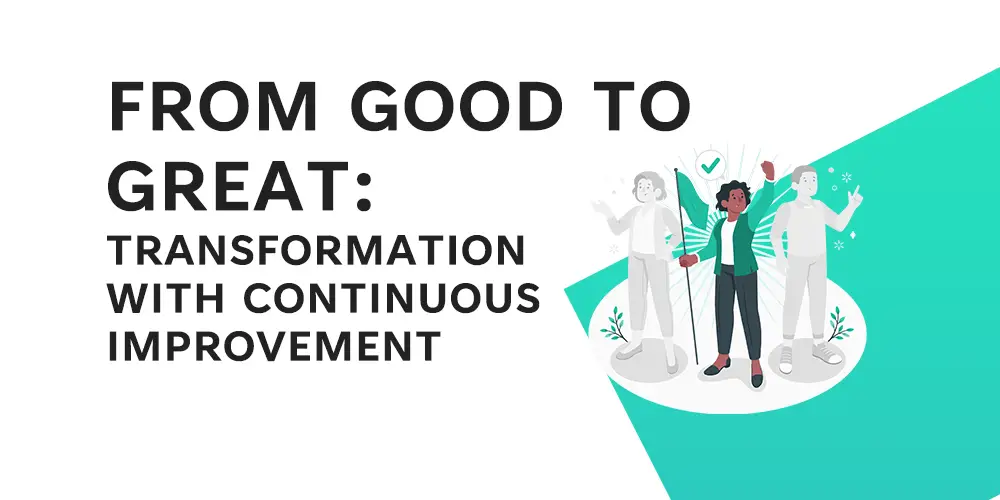The ability to adapt and improve has become an essential factor for success in today’s highly competitive and rapidly evolving business landscape. To stay ahead of the competition, manufacturing organisations, in particular, must constantly seek new ways to optimise processes, reduce costs, and improve product quality. The concept of continuous improvement comes into play here. Adopting a culture of continuous improvement can assist manufacturers in realising their full potential and transforming their operations from good to great.
A continuous improvement is a systematic approach to achieving better performance and efficiency over time by making incremental changes to processes, systems, and practises. Manufacturing organisations can drive innovation, increase productivity, and ultimately ensure long-term success by cultivating a mindset of continuous growth and learning.
In this blog post, we will discuss the principles of continuous improvement, various strategies for identifying and implementing improvements, and the importance of cultivating a culture that encourages and supports continuous progress. You will have a better understanding of how to transform your manufacturing organisation using the power of continuous improvement by the end of this post, allowing you to stand out in an increasingly competitive global market.
Table of Contents
Understanding the Principles of Continuous Improvement (CI)
The Concept of Kaizen
Kaizen, a Japanese term that means “better change,” is a fundamental principle of continuous improvement. To achieve long-term improvements, it emphasises the importance of making small, incremental changes to processes, systems, and practises. This approach is based on the belief that everyone in the organisation has a role to play in identifying and implementing opportunities for improvement, thereby fostering a collaborative culture centred on growth and progress.
Kaizen promotes continuous reflection and evaluation of current processes, the identification of inefficiencies, and the implementation of changes to improve performance. It enables organisations to tackle issues head-on and make significant progress over time by breaking complex problems down into manageable pieces. Kaizen’s continuous pursuit of perfection assists manufacturing organisations in remaining agile and adaptable in the face of change.
The Plan-Do-Check-Act (PDCA) Cycle
The Deming cycle, also known as the Plan-Do-Check-Act (PDCA) cycle, is a systematic approach to problem solving and continuous improvement. It consists of four steps that provide a structured framework for identifying, testing, and refining improvements:
- Plan: Identify a problem or area for improvement, collect data, and create a hypothesis for possible solutions.
- Do: Implement the proposed solution on a small scale while closely monitoring and collecting data on its effects.
- Check: Analyze the implementation results and compare them to the initial hypothesis to see if the proposed solution is effective.
- Act: If the solution is found to be successful, scale it up and incorporate it into standard practises. If not, revise the hypothesis and repeat the process.
The PDCA cycle encourages organisations to adapt and evolve based on the insights gained from each iteration, promoting a continuous learning process. Organizations can drive continuous improvement and achieve more efficient and effective processes by applying the PDCA cycle to various aspects of manufacturing operations.
The Role of Incremental Improvements
Incremental improvements are critical in the process of continuous improvement. Rather than aiming for drastic, large-scale changes, the emphasis is on making small, manageable changes that gradually lead to significant improvements over time. This approach recognises that true progress is often the result of a series of small changes, rather than a single large transformation.
Focusing on incremental improvements also enables organisations to be more agile and adaptive, allowing them to respond to changes and new information more quickly. Manufacturing organisations can reduce waste, increase efficiency, and improve overall performance by constantly refining and optimising processes. Furthermore, this approach fosters a culture of collaboration and innovation that drives long-term success by encouraging employee engagement and ownership of the improvement process.
Identifying Opportunities for Improvement
Analyzing Current Processes and Systems
The first step in identifying areas for improvement is to thoroughly examine your company’s current processes and systems. This entails diagramming workflows, comprehending the relationships between various steps, and identifying areas of inefficiency or waste. You can identify bottlenecks, redundant steps, and other opportunities for optimisation by gaining a thorough understanding of how your manufacturing operations work.
Process analysis tools and techniques include value stream mapping, flowcharts, and process simulation software. These tools assist in visualising the current state of your operations, making it easier to identify inefficiencies and areas for improvement.
Collecting and Evaluating Data
Data collection and analysis are critical for identifying opportunities for improvement and making informed decisions. By collecting and analysing data related to your manufacturing processes, you can uncover patterns and trends that highlight potential areas for improvement. Production reports, quality control checks, machine performance logs, and even employee feedback can all provide data.
Organizations should set up a system for organising, storing, and analysing data in order to make the most of the information gathered. Implementing data management software, creating standardised reporting templates, and training employees on data analysis techniques may all be part of this. Organizations can make more informed decisions and prioritise improvement efforts based on real-world evidence by leveraging data-driven insights.
Utilizing Key Performance Indicators (KPIs)
Key performance indicators (KPIs) are measurable indicators that assist organisations in tracking their progress towards specific goals or objectives. KPIs can be used to monitor the effectiveness of improvement initiatives and identify areas where further adjustments are required in the context of continuous improvement.
Manufacturing-specific KPIs include overall equipment effectiveness (OEE), first-pass yield, cycle time, and inventory turnover. Organizations can gauge the impact of their continuous improvement efforts and ensure they are moving in the right direction by tracking and reviewing these metrics on a regular basis.
Involving Employees in Identifying Areas for Improvement
Employees are frequently the best source of information for identifying improvement opportunities because they are directly involved in day-to-day operations. Encouraging and empowering employees to participate in the process of continuous improvement can result in valuable insights and innovative solutions that would not have been considered otherwise.
Organizations can involve employees in the improvement process by doing the following:
- Encourage an open communication and feedback culture in which employees feel comfortable sharing their ideas and concerns.
- Provide employees with training and resources to assist them in identifying and analysing opportunities for improvement.
- Establish regular employee meetings or forums to discuss potential improvements and collaborate on solutions.
- Recognize and reward employees for their contributions to the continuous improvement process, emphasising the value of their participation.
Organizations can tap into a wealth of knowledge and expertise by involving employees in the continuous improvement process, resulting in more effective and sustainable improvements over time.
Implementing Continuous Improvement Strategies
Lean Manufacturing Techniques
Lean manufacturing is a systematic approach to reducing waste and increasing efficiency in manufacturing processes. Several techniques can be used to help with continuous improvement efforts, including:
Value stream mapping: This is a visual representation of the flow of materials and information throughout the production process, from raw materials to finished products. Value stream mapping identifies waste and inefficiency while also providing a clear roadmap for improvement efforts.
5S methodology: This is a five-step workplace organisation method that includes the following steps: Sort, Set in order, Shine, Standardize, and Sustain. The 5S methodology promotes productivity and waste reduction by promoting a clean, organised, and efficient work environment.
Standard work: This refers to the establishment of clear, detailed, and documented procedures for each step in the manufacturing process. Standardized work promotes consistency, reduces errors, and streamlines processes, making it easier to identify areas for improvement.
Six Sigma Methodologies
Six Sigma is a data-driven methodology for improving quality and reducing variability in manufacturing processes. It is made up of two main methodologies:
DMAIC (Define, Measure, Analyze, Improve, Control): This is a process that is used to improve existing processes by identifying and addressing the root causes of variability and defects. The DMAIC process has five steps: define the problem, measure current performance, analyse data to identify the root cause, implement improvements, and control the process to maintain improvements.
DMADV (Define, Measure, Analyze, Design, Verify): This method is used to design new processes or products with the least amount of variability and defects. The DMADV process entails defining project goals, measuring customer needs and specifications, analysing data to develop design alternatives, designing the new process or product, and ensuring that the design meets the requirements.
There are similarities but also differences between DMAIC and DMADV, If you want to explore them more, we recommend our post on DMAIC vs DMADV.
Integrating Technology for Process Improvements
Technology integration into manufacturing processes can significantly boost continuous improvement efforts by providing new capabilities and insights. Among the key technologies are:
Automation and robotics: Using automated equipment and robotics can help to streamline processes, reduce human error, and boost productivity. Manufacturers can also collect real-time data on machine performance with automation, which can be used to identify areas for improvement and optimise processes.
Advanced analytics and data-driven decision making: Manufacturers can gain deeper insights into their operations, uncover hidden inefficiencies, and make more informed decisions about improvement initiatives by leveraging advanced analytics tools and techniques. This can include analysing data and identifying patterns, trends, and opportunities for improvement using machine learning algorithms, predictive modelling, and other advanced techniques.
Internet of Things (IoT) and Industry 4.0: The Internet of Things (IoT) is a network of interconnected devices and sensors that collect, transmit, and analyse data. In manufacturing, IoT enables real-time monitoring of equipment, processes, and environmental conditions, providing valuable insights for continuous improvement efforts. Industry 4.0 refers to the broader trend of increased digitization, interconnectivity, and data-driven decision-making in manufacturing, which can improve continuous improvement initiatives by providing new capabilities and insights.
Developing a Continuous Improvement Culture
A successful continuous improvement programme necessitates more than just implementing specific techniques and methodologies; it necessitates the development of a culture that supports and encourages continuous growth and learning. Here are some key elements in creating a culture of continuous improvement:
Leadership Commitment and Involvement
In order to foster a culture of continuous improvement, strong leadership is required. Leaders must show their dedication to the process by actively participating in improvement efforts, setting clear expectations, and providing the resources required to support continuous improvement initiatives. Leaders can help create an environment in which continuous improvement is a natural and integral part of the organization’s daily operations by modelling the behaviours and attitudes they want to see in their employees.
Employee Training and Development
Investing in employee training and development is critical for fostering a culture of continuous improvement. This includes training employees on relevant tools, techniques, and methodologies, as well as instilling in them a growth and learning mindset. Organizations can empower employees to take ownership of the improvement process and contribute to the overall success of the organisation by providing them with the knowledge and skills they need to identify and implement improvements.
Encouraging Open Communication and Feedback
Open communication and feedback are critical for identifying improvement opportunities and promoting collaboration. Organizations should foster an environment in which employees feel safe sharing their thoughts, concerns, and suggestions for improvement without fear of retaliation or judgement. Establishing regular meetings or forums for employees to discuss potential improvements, implementing suggestion box systems, or leveraging digital collaboration tools to facilitate communication are all examples of ways to accomplish this.
Recognizing and Rewarding Improvement Efforts
Recognizing and rewarding employees for their contributions to the continuous improvement process is an important part of creating a growth and learning culture. This can include acknowledging the efforts of individuals or teams who have made significant improvements, as well as providing incentives for employees to participate in the improvement process. Organizations can help reinforce the importance of continuous improvement and encourage employees to strive for excellence by demonstrating that improvement efforts are valued and appreciated.
Organizations can develop a culture of continuous improvement that drives long-term success, promotes innovation, and improves overall performance by focusing on these key elements.
Measuring Sucess and Ensuring Sustainablity
It is critical to have a robust system in place for measuring progress, evaluating the effectiveness of your initiatives, and adapting to changes and evolving industry trends to ensure the long-term success and sustainability of your continuous improvement efforts. Here are some important factors to consider:
Tracking Progress through KPIs and Metrics
As previously stated, key performance indicators (KPIs) and metrics are critical for tracking the success of your continuous improvement initiatives. You can assess the effectiveness of your efforts, identify areas where further improvements are needed, and make data-driven decisions about your improvement priorities by establishing relevant KPIs and tracking them over time.
Monitoring and reporting on these metrics on a regular basis helps keep the focus on continuous improvement and ensures that your organisation remains committed to meeting its performance targets.
Concluding Regular Audits and Reviews
Regular audits and reviews of your continuous improvement initiatives can help ensure that the changes you implement are effective and long-lasting. These audits may include internal assessments as well as third-party expert evaluations. You can identify areas where improvements have been successful and areas where further adjustments may be required by systematically reviewing your processes, systems, and practises.
Organizations should conduct regular internal reviews and discussions, in addition to formal audits, to maintain a focus on continuous improvement, share best practises, and address any emerging challenges or opportunities.
Adapting to Change and Evolving Industry Trends
To stay ahead of the competition, organisations must be prepared to adapt and evolve in a constantly changing business environment. This includes staying up to date on industry trends, emerging technologies, and changes in customer needs and preferences.
Your organisation can ensure that its continuous improvement efforts remain relevant and effective by being proactive in adapting to these changes. This may entail reevaluating your improvement priorities, updating your methodologies, or investigating new technologies and tools that can help your continuous improvement initiatives.
Celebrating Sucess and Learnign From Failures
Finally, it is critical to recognise and celebrate your continuous improvement efforts’ successes. By recognising your employees’ hard work and dedication, you can help maintain motivation and reinforce the importance of continuous improvement within your organisation.
Simultaneously, it is critical to learn from any failures or setbacks that may occur during the process of improvement. By adopting a learning and resilience culture, your organisation can use these experiences to refine its approach, identify new opportunities for improvement, and ultimately become more agile and adaptable in the face of change.
By concentrating on these factors, you can ensure the long-term success and sustainability of your continuous improvement efforts, thereby driving continuous growth and innovation within your manufacturing organisation.
Conclusion
In conclusion, continuous improvement is an essential practise for manufacturing organisations seeking to remain competitive and adapt to the ever-changing business environment. By understanding the principles of continuous improvement, identifying opportunities for optimisation, implementing effective strategies, and fostering a culture that embraces growth and learning, organisations can transform their operations from good to great.
Manufacturing organisations can cultivate a resilient and innovative workforce that drives progress and efficiency by measuring success, ensuring sustainability, and celebrating accomplishments. Accept the journey of continuous improvement and unleash the full potential of your organisation, paving the way for long-term success and industry leadership.








